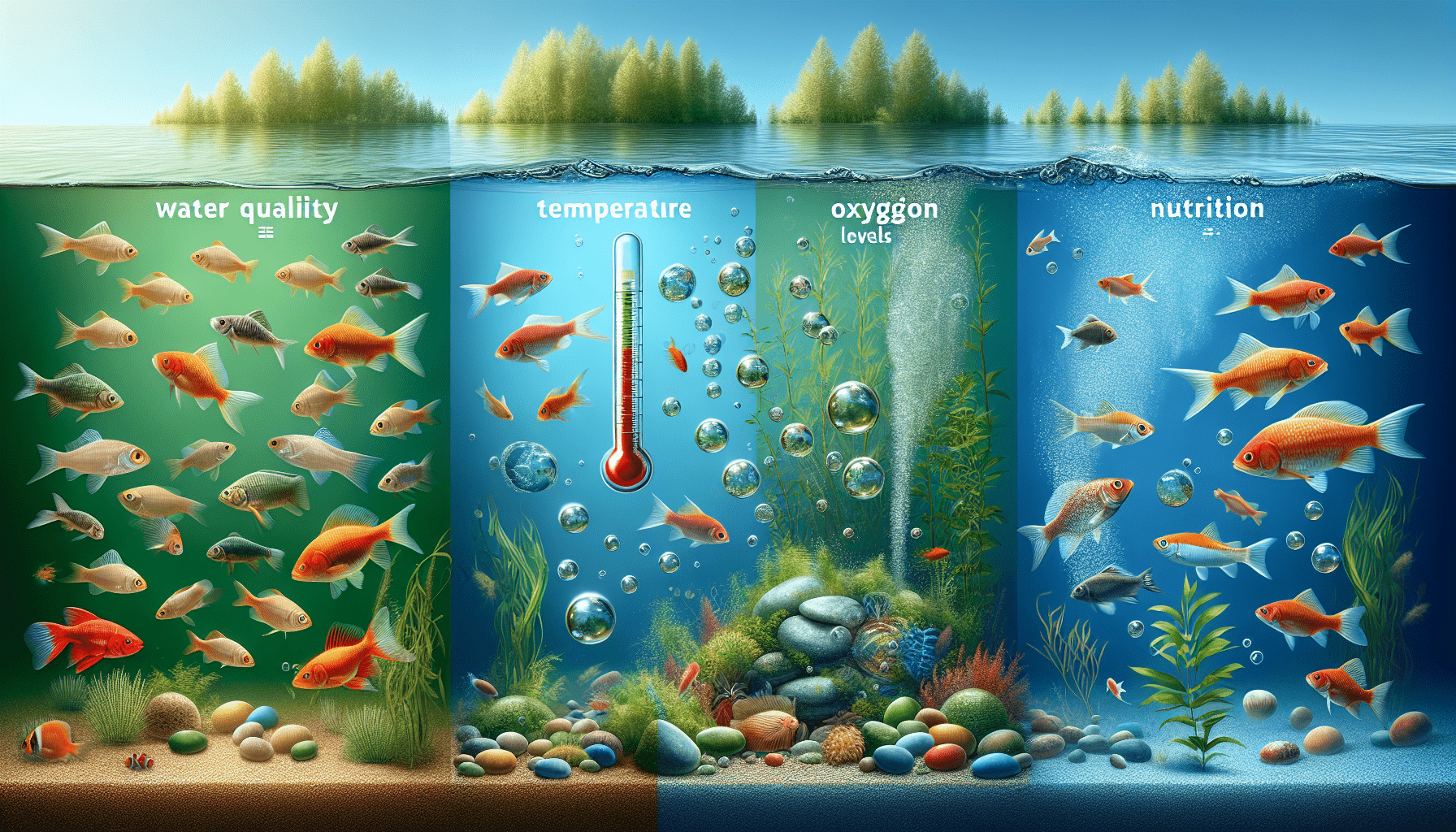In order for fish to thrive in their aquatic habitat, there are four essential elements they need to survive. These vital factors encompass everything from the quality of the water they inhabit to the availability of food sources. By understanding these four crucial elements, you will gain insight into the fascinating world of fish and their unique requirements for a healthy and sustainable life. So, let’s dive in and explore what these four things are and how they contribute to the survival of our fishy friends!
Water Quality
Clean Water
Clean water is crucial for the well-being and survival of your fish. It is important to maintain a clean and healthy environment in their tank or aquarium. Regular water changes are essential as they help remove harmful toxins and waste products from the water. You can typically perform a partial water change every 1-2 weeks, ensuring that you replace about 20-25% of the water. Additionally, it is important to invest in a high-quality filtration system that can effectively remove debris and maintain water clarity.
Proper pH Level
Maintaining the proper pH level is vital for the overall health and well-being of your fish. Different fish species thrive in different pH levels, so it is crucial to research and understand the specific requirements of the fish you intend to keep. Generally, a pH level between 6.5 and 7.5 is suitable for most freshwater fish. Regularly testing the pH level of your aquarium water and making adjustments accordingly will help create a stable and optimal environment for your fish.
Temperature
Temperature plays a significant role in the survival and health of your fish. Each fish species has its temperature preference, so it is essential to provide the appropriate temperature range for your specific fish. Investing in a reliable aquarium heater and thermometer is essential. Generally, most tropical fish thrive in temperatures around 75-80°F (24-27°C). However, it is important to research the specific temperature requirements of your fish to ensure their well-being.
Oxygen Levels
Sufficient oxygen levels are crucial for the survival of fish. In an enclosed environment like an aquarium, it is important to ensure that your fish have an adequate supply of oxygen. Aeration devices such as air pumps and air stones can help increase the oxygen levels in the water. Additionally, plants and live aquarium decorations can also contribute to oxygenation. Regularly monitoring the oxygen levels and ensuring proper aeration will help maintain a healthy and thriving aquatic environment for your fish.
Proper Nutrition
Balanced Diet
Providing your fish with a balanced diet is essential for their overall health and longevity. Different fish species have different dietary requirements, so it is crucial to research the specific needs of your fish. A balanced diet typically includes a combination of high-quality commercial fish food, live or frozen food, and occasional treats. It is important to feed your fish the appropriate amount to avoid overfeeding and maintain water quality. Observing your fish’s behavior and adjusting their diet accordingly will help ensure they receive the necessary nutrients for their well-being.
Specific Food Requirements
Certain fish species have specific dietary needs, and it is important to cater to these requirements. For example, herbivorous fish require a diet rich in plant matter such as algae wafers or blanched vegetables. Carnivorous fish, on the other hand, require a diet that includes high-protein food like bloodworms or brine shrimp. It is important to research and provide the appropriate food for your fish species to ensure their nutritional needs are met. Providing a varied diet can also help mimic their natural feeding habits and promote overall health.
A Suitable Habitat
Aquarium Size
Choosing the right aquarium size is vital for the well-being of your fish. The size of the tank should be appropriate for the number and size of fish you intend to keep. A larger tank provides more swimming space and allows for the proper growth and development of your fish. It also helps maintain better water quality by diluting waste products. It is recommended to follow the general rule of thumb, which suggests allowing at least one gallon of water per inch of adult fish.
Adequate Space
Apart from the tank size, providing adequate space within the aquarium is crucial for the comfort and well-being of your fish. Fish, like any other living creatures, need space to swim freely and exhibit natural behaviors. Avoid overcrowding the tank, as it can lead to stressed and unhealthy fish. Research the adult size and behavior of your fish species to determine the appropriate number of fish and the amount of space they require.
Appropriate Décor
Choosing appropriate décor for your aquarium not only enhances its aesthetic appeal but also provides hiding places and stimulation for your fish. Natural-looking decorations, such as rocks, caves, and plants, not only mimic the fish’s natural habitat but also create a sense of security. It is important to ensure that the décor you choose is fish-friendly, without any sharp edges or materials that can leach harmful substances into the water. Creating a well-decorated and stimulating environment will help reduce stress and promote a healthier and happier fish.
Protection from Diseases
Regular Health Check-ups
Regular health check-ups for your fish are essential to catch any signs of illness or disease at an early stage. Observing your fish closely for any changes in behavior, appetite, or physical appearance is important. Look out for symptoms like lethargy, loss of appetite, abnormal swimming patterns, or visible signs of disease. If you notice any concerns, it is advisable to consult a qualified veterinarian who specializes in aquatic animals. Early detection and timely treatment can significantly improve the chances of recovery and prevent the spread of disease to other fish.
Quarantine Tank
Using a quarantine tank is a preventive measure to safeguard the health of your existing fish population. When introducing new fish or plants to your aquarium, it is crucial to quarantine them in a separate tank for a few weeks. This isolation period helps prevent the introduction of potential diseases or parasites to your established aquarium. During quarantine, closely monitor the health and behavior of the new additions before introducing them to the main tank. A quarantine tank provides a controlled environment for monitoring and treating any potential health issues.
Disease Prevention Measures
Preventing the occurrence and spread of diseases is key to maintaining a healthy fish population. Practicing good hygiene and cleanliness in your aquarium is vital. Avoid introducing potential sources of disease, such as contaminated water, equipment, or fish from unreliable sources. Quarantining new additions, as mentioned earlier, is an effective way to minimize the risk of diseases. Regularly cleaning the aquarium, maintaining proper water quality, and monitoring the health of your fish will help prevent the outbreak and spread of diseases.
In conclusion, providing the four essential elements for fish survival – clean water, proper nutrition, a suitable habitat, and protection from diseases – is crucial for the well-being and longevity of your fish. By understanding and meeting these requirements, you can create a thriving aquatic environment that promotes the health, happiness, and beauty of your fish. Remember to research specific requirements for your fish species and consistently monitor and maintain their environment to ensure their optimal well-being.

My name is James Gheen, and I am thrilled to welcome you to Tropical Fish Farmers, the ultimate destination for everything related to tropical fish breeding. As an avid underwater enthusiast, I am dedicated to sharing my knowledge and experience to help you successfully breed and care for tropical fish. Whether you’re a beginner starting your aquarium journey or a seasoned breeder looking to expand your knowledge, my website has something for everyone. Dive into our extensive library of articles, tutorials, and videos covering various topics to enhance your breeding success. Join me in our vibrant community and let’s contribute to responsible fish breeding and conservation efforts together. Discover Tropical Fish Farmers and become part of our global community today.

